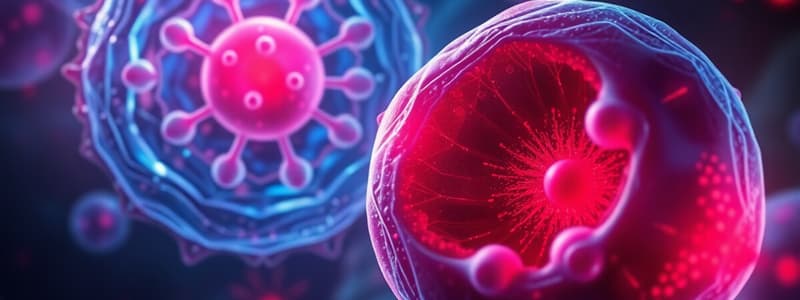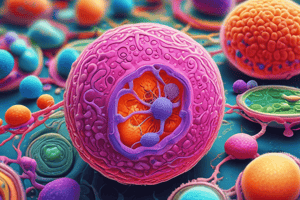Podcast
Questions and Answers
What type of cells are animal cells?
What type of cells are animal cells?
- Prokaryotic
- Eukaryotic (correct)
- Archaea
- Bacterial
Which of the following is a key function of the cell membrane?
Which of the following is a key function of the cell membrane?
- Generating energy
- Storing genetic material
- Controlling what enters and exits the cell (correct)
- Synthesizing proteins
Which organelle is responsible for generating energy through aerobic respiration?
Which organelle is responsible for generating energy through aerobic respiration?
- Ribosomes
- Mitochondria (correct)
- Endoplasmic reticulum
- Golgi apparatus
What is the main function of ribosomes?
What is the main function of ribosomes?
Which of the following structures is NOT found in animal cells?
Which of the following structures is NOT found in animal cells?
What does the nucleus contain?
What does the nucleus contain?
The Golgi apparatus is also known as:
The Golgi apparatus is also known as:
What is the function of lysosomes?
What is the function of lysosomes?
Which structure separates the nucleus from the rest of the cell?
Which structure separates the nucleus from the rest of the cell?
Where does protein packaging and secretion happen?
Where does protein packaging and secretion happen?
What is the watery interior of the cell called?
What is the watery interior of the cell called?
What is the function of the smooth ER?
What is the function of the smooth ER?
What is another name for the plasma membrane?
What is another name for the plasma membrane?
What are the series of compartments in the golgi apparatus known as?
What are the series of compartments in the golgi apparatus known as?
Which of these processes happens in the cytoplasm?
Which of these processes happens in the cytoplasm?
Flashcards
Animal Cells
Animal Cells
Basic structural and functional units of living organisms, carrying out life's activities.
Characteristics of Animal Cells
Characteristics of Animal Cells
Eukaryotic cells with membrane-covered organelles, a nucleus, and mitochondria, found in organisms of the animal kingdom.
Plasma Membrane
Plasma Membrane
Outer boundary separating the cell from its environment, controlling substance passage, and maintaining cell balance.
Nucleus
Nucleus
Signup and view all the flashcards
Cytoplasm
Cytoplasm
Signup and view all the flashcards
Organelles
Organelles
Signup and view all the flashcards
Mitochondria
Mitochondria
Signup and view all the flashcards
Ribosomes
Ribosomes
Signup and view all the flashcards
Golgi Apparatus
Golgi Apparatus
Signup and view all the flashcards
Endoplasmic Reticulum (ER)
Endoplasmic Reticulum (ER)
Signup and view all the flashcards
Rough ER
Rough ER
Signup and view all the flashcards
Smooth ER
Smooth ER
Signup and view all the flashcards
Cellular Respiration
Cellular Respiration
Signup and view all the flashcards
Cytoplasm Function
Cytoplasm Function
Signup and view all the flashcards
Organelle Function
Organelle Function
Signup and view all the flashcards
Study Notes
- Cells are the structural and functional units of life, and determine an organism's activities.
- Animal cells are eukaryotic, containing membrane-covered organelles, a nucleus, and mitochondria.
- Animal cell shapes and sizes vary based on their function, such as concave red blood cells or elongated nerve cells.
Animal Cell Structure and Functions
- The outer cell membrane separates the cell from the external environment and can be modified for specific functions like movement and feeding.
- Cytoplasm is a jelly-like fluid filling the cell, housing organelles.
- Organelles perform specific jobs within the cell.
- The nucleus is the control center, containing DNA and regulating cell activities like metabolism, growth, and reproduction.
- Mitochondria are responsible for cellular aerobic respiration.
- Lysosomes digest and recycle toxic substances and waste.
- Animal cells lack a cell wall.
- Animal cells provide structure, absorb nutrients, convert nutrients to energy, enable movement, and store/transfer hereditary material.
Plasma Membrane
- Composed of a phospholipid bilayer, separating the cytoplasm from cell organelles.
- Selectively permeable, controlling substances entering and exiting organelles to maintain homeostasis.
Nucleus
- The control center and regulates cellular activities, including growth and cell division
- Contains DNA, the cell's genetic material.
- DNA and histone proteins form chromosomes, which pass genetic information.
- The nuclear membrane separates the nucleus from the rest of the cell.
- Contains the nucleolus, where ribosomal RNA associates with proteins to form ribosomes.
Cytoplasm
- The watery interior of the cell contains ions, and proteins, allowing cells to maintain turgidity
- Most cellular activities take place in the cytoplasm.
- Organelles are suspended in the cytoplasm.
- Contains molecules and enzymes for waste breakdown, metabolic activities, and glycolysis (first step in cellular respiration).
- Cytosol, within the cytoplasm, lacks organelles but contributes to cell shape.
Cell Organelles
- Structures performing various jobs within the cell to maintain balance and keep the cell alive.
- Include the nucleus, mitochondria, ribosomes, lysosomes, vacuoles, endoplasmic reticulum, and Golgi apparatus.
Mitochondria
- Converts oxygen and nutrients into energy via aerobic respiration.
- The number of mitochondria varies depending on the cell type such as heart cells needing more mitochondria
- Oblong organelles with inner and outer membranes and a matrix.
- The inner membrane folds to form cristae.
- Membranes are made of proteins and phospholipid layers separated by the intermembrane space.
Ribosomes
- Synthesize proteins needed by the cell, aiding in cellular repair, growth, and enzyme formation.
- Composed of small (mRNA) and large ribosomal subunits, which bind to mRNA to facilitate protein synthesis.
Golgi Apparatus
- Packages and secretes proteins.
- Receives proteins from the endoplasmic reticulum (ER).
- Comprises compartments called cisternae (flattened, disk-shaped, stacked pouches).
- Ribosomes can be scattered or attached to the ER such as the rough ER possessing ribosomes
- Proteins are packaged in vesicles and sent to different cell organelles from the Golgi body
- Smooth ER lacks ribosomes, synthesizes lipids and fats, and acts as the cell's detoxification center.
Studying That Suits You
Use AI to generate personalized quizzes and flashcards to suit your learning preferences.




